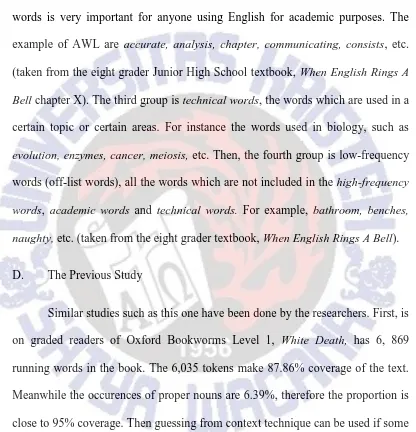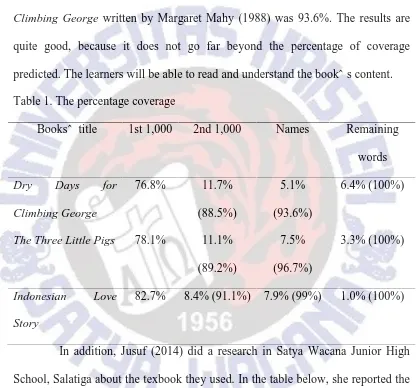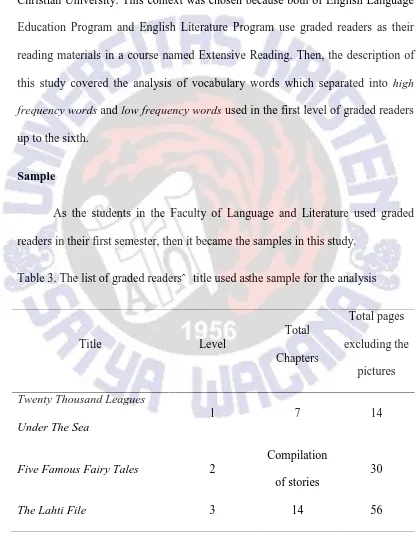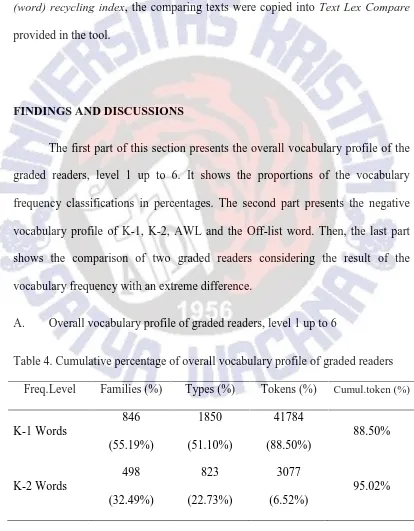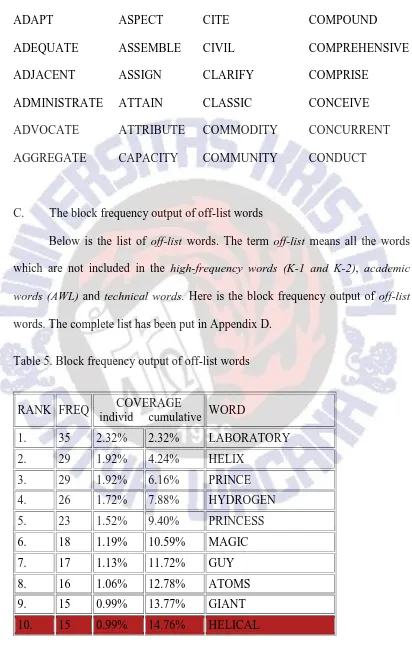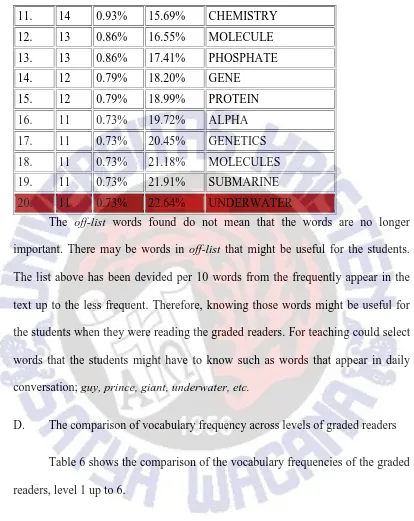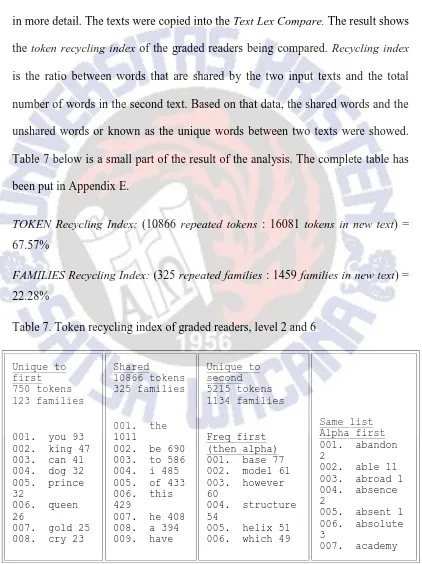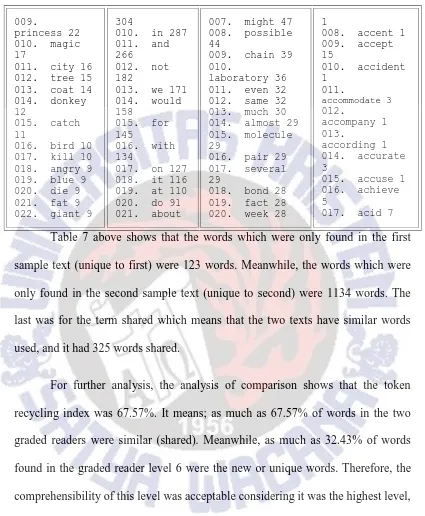VOCABULARY PROFILE OF GRADED READERS USED IN
THE FACULTY OF LANGUAGE AND LITERATURE, SATYA
WACANA CHRISTIAN UNIVERSITY
THESIS
Submitted in Partial Fulfillment
of the Requirements for the Degree of Sarjana Pendidikan
Pawinda Tiffany Putri
112012126
ENGLISH LANGUAGE EDUCATION PROGRAM
FACULTY OF LANGUAGE & LITERATURE
SATYA WACANA CHRISTIAN UNIVERSITY
INTRODUCTION
The way to learn vocabulary is not always from reading academic books.
It can also be done through different ways such as reading stories or watching movies. According to Nation (2001, p.17) different genres of reading materials have different frequency profiles. The vocabulary used in the academic books and
story books have different levels of difficulties. In the Faculty of Language and Literature (FLL) of Satya Wacana Christian University (SWCU), both in English
Language Education Program and English Literature Program, there is a course named Extensive Reading which requires the students to read a minimum of 1000 pages in order to pass the course. Nation (2001, p.144) found that the learners will
be able to increase their comprehension ability in reading text after passing a certain boundary described as vocabulary ‘thresholds’. The criteria for the
‘ thresholds’ wasthat the learners have to acquire 95% of vocabulary from the
reading passage in order to understand the text. According to that statement, vocabulary certainly is important in reading. As mentioned above, by reading
around that 1000 pages, learners’ vocabulary are expected to increase.
The books used in the Extensive Reading course are graded readers which
are Penguin Readers and Cambridge English Readers. The books which can be found in the SWCU library are published by Pearson Education Limited and Cambridge University Press. According to Kurniawati (2015), a lecturer of
the beginning of the semester. If the academic books are used in the first semester, the learners will find English as a difficult subject. Therefore, graded readers are
used. Based on this reason, profiling the vocabulary used in the graded readers is important, because those books have different levels, from level 1 up to 6. This
means that the books have different levels of vocabulary difficulties. It is important to profile the graded readers used in this department because by providing an appropriate assistance for the new students will help them to acquire
important vocabulary knowledge during the course.
Based on the explanation above, the research questions for this study were:
1. What is the vocabulary profile of graded readers used in the Faculty of
Language and Literature, Satya Wacana Christian University?
2. What is the proportions of vocabulary that is not covered in the graded
readers?
3. What is the token (word) recycling index of the graded readers?
Then, the objective of this study were to identify the vocabulary profile of
the graded readers used in English Language Education Program at the Faculty of Language and Literature, Satya Wacana Christian University. Besides, this study
also aimed to produce lists of vocabulary that were not covered in the graded readers and the last was to produce the token (word) recycling index of the graded
By doing this research, I hoped that the learners would have information to improve their vocabulary they have learned through reading graded readers.
Moreover, through these books, the learners can learn vocabulary from the beginner level to the advanced level and measure their own vocabulary
knowledge. I also hoped that the result of this study could help the teacher to teach the learners about reading comprehension by knowing which words should be taught first. The more vocabulary known by the students the easier they will
understand the reading passages. In that way, teachers will not spend too much time to teach all the vocabulary in the text, they can focus on what learners need.
LITERATURE REVIEW
A. Learning Vocabulary through Reading
In learning English as a foreign language, vocabulary is the biggest
problem that learners should face. According to McCharty (1992), cited in Asgari and Mustapha (2011), without words to express meaning, communication in L2
will be impossible to happen in any meaningful way. That means vocabulary is everything in language learning. There are many ways to learn vocabulary, especially when the learners should learn it within the context or discourse. The
learning vocabulary can be done through reading, conversation, movies, television, radio, etc (Nation, 2001). It is widely known that reading is one of the
effective methods to acquire new vocabulary for the L2 learners. Though another method can be used to support learning vocabulary such as listening, imitating,
Carver (2000, 2003, as cited in Grabe, 2009) claimed that vocabulary knowledge and reading comprehension has almost a perfect correlation. To
support that statement, Pike (1979), cited in Grabe (2009), reported the correlations of vocabulary and the reading on TOEFL test is r= .88 to r= .94. It
means that reading and vocabulary are things which cannot be separated. Fisher and Frey (2014) stated that vocabulary lies at the heart of content learning, as it
serves as a proxy for learners’ understanding of concepts. In reading activities,
when the learners cannot understand the meaning of the words, they might not understand the content of the book and get nothing from it. In many cases learners
experience difficulties in understanding the meaning of a text because it contains numbers of unknown words. They usually skip reading the sentence or the paragraph (Noor & Amir, 2009) and do not try to know the words. As a result, the
learners may leave the words to be unknown and they may not increase their vocabulary knowledge. That is why vocabulary becomes an important key in
learning the target language.
Learning vocabulary through reading has various types of learning activities depending on the learner’ s need.There are two types of reading
activities, intensive reading and extensive reading. According to Nation (2008, p. 59) in intensive reading learners are engaged with the details of the text which
have two goals: understanding the text and language features. This activity could help the learners develop strategies to deal with the unknown words in the reading text. Nation (2008, p. 59) found that the reading passages such as newspaper,
reading are short, around 300-500 words long. On the other hand, Nation (2008, p. 70) stated that extensive reading involves the reading activity which focuses on
the meaning of the text rather than on its language feature. Examples of extensive reading text commonly used are graded readers, novels, and other non-fiction
books.
In conclusion, learners can acquire vocabulary knowledge through reading abundantly. According to Webb and Chang (2015), the more texts that are read by
the learners, the more opportunities to meet the repeated words. In this study, the focus is on extensive reading activity through graded readers. If two or more
graded readers are read in a week, it is expected that the learners’ vocabulary
knowledge will increase incidentally by reading the same words in a short period of time. Webb and Chang (2015) stated that the purpose of reading graded readers
is to develop high frequency words, not to develop vocabulary for a certain topic or genre for example like vocabulary used in biology. Thus, the leaners will find
their vocabulary knowledge they get through graded readers is useful despite of the reading materials used later on.
B. Teaching Vocabulary through Reading
The reading activities in intensive and extensive reading have their own goals for the learners. That is why knowing L2 learner’ s needs become an
can make the vocabulary learning to occur is 95% (p. 148). This percentage of the word frequency is expected not to burden the learners. When the reading text has
80% or below the 95% of the text coverage, the text is quite difficult for the learners to understand. This amount of percentage is also intended for the
non-fiction books or other reading passages for general or academic purposes. Based on Hu and Nation (2000), cited in Schmitt, Jiang and Grabe (2011), it takes
98%-99% coverage of reading for pleasure.
However, language teachers usually tend to teach their students the vocabulary which they think students will encounter. Very often, the teachers do
not have enough time to teach all the vocabulary their students may need (Alhaysony, 2012). This is the case which usually happens in the traditional classroom learning activity. The teacher will directly translate difficult words into
the learners’ mother tongue (L1). Some people believe this is an easy way, but
then actually it takes so much time and the probability of students’ dependence
toward the teacher may increase. Schmitt (2000), cited in Alhaysony (2012), states that there is individual differences between the learners, therefore, it will be
quite difficult in deciding what vocabulary students should learn.
Based on the explanation above, there are some effective ways that the teacher can do to overcome this problem. One of them is extensive reading. Eskey (2005), cited in Li and Zhang (2009), argues that when the learners found at least
just one unknown word in every twenty words, they will not feel frustrated and will continue to read. Thus, the teacher should provide appropriate text materials
expected goal. The goals are developing learners’ fluency in reading, reading
comprehension, and reading for pleasure (Nation, 2008). For instance, graded
readers which are included in fiction book can be used for extensive reading learning activities. The teacher can give the reading materials which are somewhat
challenging but not exceeding the learners’ lexical competence too much (Li & Zhang, 2009). By using graded readers as the reading materials, the learners can start reading from the level in which they are able to handle then go to the higher
one. Yet, the teachers have to facilitate the students in learning vocabulary. For example, they can teach the students how to use some strategies in learning new
words, like using dictionaries, guessing words, taking notes or even social strategy. Based on Alhaysony (2012), teachers are often in the position of the one
who knows everything and can answer the students’ question.Therefore, when the
students ask about the unknown words to the teacher, they can answer question using the L1 translation, synonym, definition, or using the new word in a sentence
(Alhaysony, 2012). Through those strategies, it will help the students to understand the new vocabulary easily. Besides, the teachers can guide their students to learn the words they may need more like high frequency words. As a
result, the students’ vocabulary learning activity through reading can be done
smoothly.
C. Vocabulary Profiler
anymore. Graves (2015) stated that vocabulary profile is an aggregation of word frequencies. Meanwhile, vocabulary profile or text coverage is the total number of
words used in the text, minus the amount of unused words (negative words) and it is converted into a percentage (Laufer & Ravenhorst-Kalovski, 2010). If the
reading activity occurs, many kinds of reading materials might be used such as newspapers, graded readers, textbooks, etc. The important point is that every genre of reading materials has different kind of vocabulary style and difficulty.
Thus, profiling them is important and useful to differentiate the reading materials
considering the learners’ needs and reading goal.In this study, my objective was
to identify the vocabulary used in graded readers. Nation (2008, p.71) reported that graded readers cover around 300-500 words for the beginner level, and 2000-2500 for the advanced level. Thus, this study aimed to find the percentage of the
text coverage of graded readers, because the books have different levels, level 1 up to 6.
To reach the objective which has been set, the texts in the graded readers were analyzed using lexical profiler available at Tom Cobb’ s website
(http://lextutor.ca) (Laufer & Ravenhorst-Kalovski, 2010). The texts were copied
into the vocabulary profiler to produce the analysis. Based on Nation (2001, p. 11-12) there are four levels of vocabulary in a text: the first group is high-frequency
words which are included in A General Services List of English Words. It contains
around 2,000 word families. The 2,000 words are divided into the first most 1,000 words frequently used 1) and the second most 1,000 words frequently used
the example K-2 words are afternoon, quickly, suddenly, tomorrow, etc. (taken from graded reader, Twenty Thousand Leagues Under The Sea chapter 2 by Jules
Verne). The second group is the academic words list (AWL). This small list of words is very important for anyone using English for academic purposes. The
example of AWL are accurate, analysis, chapter, communicating, consists, etc. (taken from the eight grader Junior High School textbook, When English Rings A
Bell chapter X). The third group is technical words, the words which are used in a
certain topic or certain areas. For instance the words used in biology, such as
evolution, enzymes, cancer, meiosis, etc. Then, the fourth group is low-frequency
words (off-list words), all the words which are not included in the high-frequency
words, academic words and technical words. For example, bathroom, benches,
naughty, etc. (taken from the eight grader textbook, When English Rings A Bell).
D. The Previous Study
Similar studies such as this one have been done by the researchers. First, is on graded readers of Oxford Bookworms Level 1, White Death, has 6, 869
running words in the book. The 6,035 tokens make 87.86% coverage of the text. Meanwhile the occurences of proper nouns are 6.39%, therefore the proportion is
close to 95% coverage. Then guessing from context technique can be used if some difficult words appear (Wan-a-rom, 2008).
Table 1 below was a research done by Nation in 2001. Nation (2001, p.
152) did a research on the frequency of vocabulary on graded readers, Indonesian
The result shows that from the most frequent 2000 words of English plus names, the percentage calculated for Indonesian Love Story was 99%. In The
Three Little Pigs in the Ladybird series (Elley and Mangubhai, 1981: 26) cited in
Nation (2001, p. 153) the percentage found was 96.7%, and in the Dry Days for
Climbing George written by Margaret Mahy (1988) was 93.6%. The results are
quite good, because it does not go far beyond the percentage of coverage predicted. The learners will be able to read and understand the book’ s content.
Table 1. The percentage coverage
Books’ title 1st 1,000 2nd 1,000 Names Remaining words
The Three Little Pigs 78.1% 11.1%
(89.2%)
School, Salatiga about the texbook they used. In the table below, she reported the result of vocabulary coverage analysis from 50% of the reading texts only which are taken from English textbook, English on Sky for grade 7.
Table 2. The percentage coverage of English on Sky for grade 7, chapter 1-7
Chapter K1 words (1-1000)
K2 words (1001-2000)
1 68.91% 7.00% 0.10%
2 83.91% 5.59% 0.19%
3 79.53% 4.57% 3.55%
4 80.21% 12.53% 0.95%
5 83.81% 5.17% 0.56%
Jusuf (2014), found that in every chapter of English on Sky textbook for
grade 7, there are different topics discussed which influence the vocabulary used. Thus, she suggested that the teacher should have reference lists of words whether
a particular word needs attention or not.
In SWCU there were some studies which have been done by researchers on vocabulary profile. They used different kinds of data, like junior high school
textbook, IC textbook, etc. However, the analysis of vocabulary profile of graded readers have not been done. Thus, I decided to analyze the graded readers’ s
vocabulary coverage.
THE STUDY
Method of Research
This study used a descriptive method in analyzing the data. According to Aggarwal (2008) cited in Salaria (2012), descriptive research is intended to collect the information which is revealing conditions or situation for the purpose of
description and interpretation. Sometimes it used visual aids such graphs, charts or tables to help the reader in understanding the data. This type of research was
interpretation, comparisons, identifications, etc. According to the statements, this study described the vocabulary profile used in the graded readers. The graded
readers are used in the Faculty of Language and Literature, Satya Wacana Christian University. This context was chosen because both of English Language
Education Program and English Literature Program use graded readers as their reading materials in a course named Extensive Reading. Then, the description of this study covered the analysis of vocabulary words which separated into high
frequency words and low frequency words used in the first level of graded readers
up to the sixth.
Sample
As the students in the Faculty of Language and Literature used graded readers in their first semester, then it became the samples in this study.
Table 3. The list of graded readers’ title used as the sample for the analysis
Title Level
Total Chapters
Total pages excluding the
pictures
Twenty Thousand Leagues
Under The Sea
1 7 14
Five Famous Fairy Tales 2
Compilation of stories
30
The Amsterdam Connection 4 16 72
In the Shadow of The
Mountain
5 21 91
The Double Helix 6 15 102
Total - 73 365
In Table 3 showed the list of graded readers used as the samples. The
graded readers found in the Satya Wacana Christian University’ s librarywere Penguin Readers and Cambridge English Readers. These books were published by
Pearson Education Limited and Cambridge University Press. I used stratified and systematic sampling technique to select the data from the sample graded readers.
As the sample of this research, I took 50% of pages each book.
Research Instrument
In order to produce the analysis of vocabulary used in graded readers, I
used a tool named vocabulary profiler. This tool can be found in a website,
www.lextutor.ca. It is the Tom Cobb’ s websiteavailable in lextutor.ca. There were many functions of the tool related to this study. Like, first it showed the
result of vocabulary’ s frequency used in the text.It can also show where the words belong, high frequency words or low frequency words. It can give analysis
Data Collection Procedures
The graded readers were selected as much as 50% from the whole pages
due to the limitation of inputted words in the vocabulary profiler, lextutor.ca which is 60,000 words. Meanwhile, there were 6 graded readers being analyzed.
However, the texts were cleaned up from the unnecessary components. First, numbers (including page, chapter, date, year, age, etc.) and punctuation marks were excluded from the data. Second, proper names including names of persons,
places, brand of goods, and so on also were deleted from the data. The pages selected and cleaned were copied into the tool as the sample to analyze the
vocabulary used in the graded readers. Actually the tool can read this kind of data, but they were excluded from analysis because those unnecessary component influenced the percentage of the analysis later on, meanwhile those components
were easily recognized by the students in their reading activity.
Data Analysis Procedures
Then, from the pages which had been selected, the text were copied into the tool provided. The first step was opened the lextutor.ca website, then clicked the Vocabprofiler. After that, the VP Classic and the blank space were appeared.
In this space the text copied and clicked submit the window. Then, automatically the analysis of the cumulative percentage showed. After that, the description of
were not covered or the negative words appeared. Therefore, the whole data were put to show the overall result of the analysis. Then, after that, the data were put
one by one from the first level up to the sixth level of graded readers to show the vocabulary profile differences occured between the level. To find out the token
(word) recycling index, the comparing texts were copied into Text Lex Compare
provided in the tool.
FINDINGS AND DISCUSSIONS
The first part of this section presents the overall vocabulary profile of the
graded readers, level 1 up to 6. It shows the proportions of the vocabulary frequency classifications in percentages. The second part presents the negative vocabulary profile of K-1, K-2, AWL and the Off-list word. Then, the last part
shows the comparison of two graded readers considering the result of the vocabulary frequency with an extreme difference.
A. Overall vocabulary profile of graded readers, level 1 up to 6
Table 4. Cumulative percentage of overall vocabulary profile of graded readers
Freq.Level Families (%) Types (%) Tokens (%) Cumul.token (%)
K-1 Words
846
(55.19%)
1850
(51.10%)
41784
(88.50%)
88.50%
K-2 Words
498
(32.49%)
823
(22.73%)
3077
(6.52%)
AWL profile used in graded readers was based on word families, types and token. The
term families or word families refers to the head of word. For example, confuse is the head word of confused or confusing. The term type, is the variation of form
words in the same families. Therefore, confuse, confused and confusing are considered as the same type. While figure and create are considered as the different types. Last is token; the total number of words in the input text. For
instance if the result of analysis in the tool shows, leagues [5], prince [20], acid [4] and wallet [3], the number of token is 32. That is why token shows the highest
number in the table presented above.
The cumulative percentage in the table shows that the use of K-1 words was 88.50% with the additional of K-2 words (6.52%), so the total of K-1 and K-2
was 95.02%. According to Hu and Nation (2000) cited in Schmitt, Jiang and Grabe (2011), it takes 98%-99% of word knowledge for the purpose of reading for
knowledge. Meanwhile, the AWL percentage was 1.73%. The AWL which commonly appear in the academic texts, were also found in the graded readers.
The total academic words found were 817 words. Then, the question that should be considered is how the AWL words should be taught in this course. The last
category is the off-list words which covered 3.25%. By having around 1536 words included in the off list words, the teacher and the students should consider how to handle those words. There might be some words which are useful for the students
to know.
B. Negative Vocabulary Profiles of The Graded Readers
In this section, the negative words of K-1, K-2, AWL and the Off-list word will be presented. Negative words or negative vocabulary is the words or vocabulary which are not found in the graded readers. The experts have created
the list of K-1, K-2 and K-3 (AWL) words which is known as the New General Service List (NGSL). Then, the negative words which were not found in the
graded readers were analyzed by comparing the words on the sample texts and the NGSL. The use of NGSL helped the researcher to know what words included in
graded readers and what were not.
1. The negative VP of K-1
Below are the analysis of negative words of K-1 found in the samples of
the graded readers. Here is the summary of the analysis of K-1.
K-1 families not in input : 130 (13.49%)
The percentage shows above is different from the cumulative percentage
presented in the first table (overall vocabulary profiles) because the percentages here refer to the word families (head word). For further analysis, the total
percentage of K-1 words families found in the text (in input) was 86.62% which means, the books used around 86.62 % words in the NGSL. Then, the remaining 13.49% was the words which were not found in the texts (not in input) based on
the NGSL. Some words which were not found in the text (negative words) were listed below. The complete word list has been attached in the Appendix A.
CASTLE
2. The negative VP of K-2
Then the negative VP of K-2 found in the samples of the graded readers were presented below.
K-2 total word families : 986
K-2 families in input : 498 (50.51%)
K-2 families not in input : 489 (49.59%)
Based on the NGSL the words found to be used in graded readers (in input) was 50.51%. Then the remaining 49.59% was the words which were not
found (not in input) in the sample texts. Some words which were not found in the text (negative words) were listed below. The complete word list has been attached
ADVERTISE
3. The negative VP of AWL (K-3)
The last was the negative VP of K-3. The following analysis was showed
that the words found in the sample texts (in input) based on NGSL was 33.22%. Meanwhile the words which were not found (not in input) in the graded readers
was 66.96%.
K-3 total word families : 569
K-3 families in input : 189 (33.22%)
K-3 families not in input : 381 (66.96%)
Below was the list of some negative words found in the graded readers as the sample texts. The complete word list has been attached in the Appendix C.
ADAPT
C. The block frequency output of off-list words
Below is the list of off-list words. The term off-list means all the words
which are not included in the high-frequency words (K-1 and K-2), academic
words (AWL) and technical words. Here is the block frequency output of off-list
words. The complete list has been put in Appendix D.
Table 5. Block frequency output of off-list words
RANK FREQ COVERAGE
individ cumulative WORD
1. 35 2.32% 2.32% LABORATORY
2. 29 1.92% 4.24% HELIX
3. 29 1.92% 6.16% PRINCE
4. 26 1.72% 7.88% HYDROGEN
5. 23 1.52% 9.40% PRINCESS
6. 18 1.19% 10.59% MAGIC
7. 17 1.13% 11.72% GUY
8. 16 1.06% 12.78% ATOMS
9. 15 0.99% 13.77% GIANT
11. 14 0.93% 15.69% CHEMISTRY
12. 13 0.86% 16.55% MOLECULE
13. 13 0.86% 17.41% PHOSPHATE
14. 12 0.79% 18.20% GENE
15. 12 0.79% 18.99% PROTEIN
16. 11 0.73% 19.72% ALPHA
17. 11 0.73% 20.45% GENETICS
18. 11 0.73% 21.18% MOLECULES
19. 11 0.73% 21.91% SUBMARINE
20. 11 0.73% 22.64% UNDERWATER
The off-list words found do not mean that the words are no longer important. There may be words in off-list that might be useful for the students. The list above has been devided per 10 words from the frequently appear in the
text up to the less frequent. Therefore, knowing those words might be useful for the students when they were reading the graded readers. For teaching could select
words that the students might have to know such as words that appear in daily conversation; guy, prince, giant, underwater, etc.
D. The comparison of vocabulary frequency across levels of graded readers
Table 6 shows the comparison of the vocabulary frequencies of the graded readers, level 1 up to 6.
Table 6. The comparison of VP across levels graded readers
K-1 words K-2 words AWL Off-list words
Level 1 92.96% 3.67% 0.35% 3.01%
Level 3 90.37% 7.07% 0.50% 2.06%
Level 4 90.41% 6.08% 0.92% 2.59%
Level 5 90.86% 6.11% 0.97% 2.06%
Level 6 84.70% 6.90% 3.69% 4.71%
As seen in the Table 6, an interesting finding was an extreme percentage
appeared in the AWL frequency level of graded reader level 2 which was 0.00%. From 6 graded readers, level 2 taken was the book entitled Five Famous Fairy
Tales. It told about nonsense stories intended purely for reading for pleasure.
Therefore, the appearance of AWL was few in this level. Yet, the use of K-1 words for this level was the highest; 93.19%. The example words used were
beautiful, brother, country, loved, etc.
Meanwhile, the frequency of AWL in the graded reader level 6 was the highest;3.69%. The book’ s title wasThe Double Helix. The book told about how
DNA was created. So there were many words used in biology, such as protein,
atomic, theory, etc. The example of AWL were abandon, academy,
accomodation, achieve, etc. While the sample of level 6 taken showed the highest
percentage of AWL, the K-1 words had the lowest percentage among other readers; 84.70%. There were many difficult words to understand considering that
these books are intended for the first semester of college students. Yet, it was acceptable because the purpose of reading the graded readers was also to increase
E. The text comparison of graded readers, level 2 and 6
This is the last part of the analysis. Based on the difference of AWL
percentage between level 2 and 6, then the two graded readers have been analyzed in more detail. The texts were copied into the Text Lex Compare. The result shows
the token recycling index of the graded readers being compared. Recycling index is the ratio between words that are shared by the two input texts and the total number of words in the second text. Based on that data, the shared words and the
unshared words or known as the unique words between two texts were showed. Table 7 below is a small part of the result of the analysis. The complete table has
been put in Appendix E.
TOKEN Recycling Index: (10866 repeated tokens : 16081 tokens in new text) =
67.57%
FAMILIES Recycling Index: (325 repeated families : 1459 families in new text) =
22.28%
Table 7. Token recycling index of graded readers, level 2 and 6
009. sample text (unique to first) were 123 words. Meanwhile, the words which were
only found in the second sample text (unique to second) were 1134 words. The last was for the term shared which means that the two texts have similar words
used, and it had 325 words shared.
For further analysis, the analysis of comparison shows that the token recycling index was 67.57%. It means; as much as 67.57% of words in the two
graded readers were similar (shared). Meanwhile, as much as 32.43% of words found in the graded reader level 6 were the new or unique words. Therefore, the
comprehensibility of this level was acceptable considering it was the highest level, so it should have a little much of new vocabulary than the other levels.
CONCLUSION
The purpose of this study were to identify the vocabulary profile of the
Christian University, to produce lists of vocabulary that were not covered in the graded readers and to produce the token (word) recycling index of the graded
readers. The investigation of graded readers, level 1 up to 6 has shown that the word coverage of the graded readers samples were 88.50% for 1, 6.52% for
K-2, 1.73% for AWL and 3.25% for Off-List word.
Based on NGSL, the major finding is that the words not found in the graded
readers’ were 13.49% of K-1, 49.59% of K-2, and 66.96% of AWL. Besides, this
study has also shown that the comparison of level 2 and 6 of graded readers shows that there were some shared words which was 67.75% and unshared words
(unique) which was 32.43%.
The results of this study indicate that the use of graded readers in Extensive Reading course was quite appropriate to the course. Although the total of high
frequency words (K-1 & K-2) was less than the expected word knowledge for reading for pleasure which was took 98%-99% (Hu & Nation, 2000, as cited in Schmitt, Jiang & Grabe, 2011), but it passed the minimum threshold mention by
Nation (2001, p. 144) which was 95.02%. From the teaching perspective it was appropriate to use such reading materials; graded readers, because it contains
many new vocabulary wrapped in many fiction stories. From the learning perspective, using graded readers brought less pressure for the learners to learn English as the foreign language. Yet, it was a good suggestion that the learners
The last thing being highlighted was the study did not evaluate the technical words used in the graded readers. Therefore, the question raised by this study is
“What is the technical word used in the graded readers or another sample text
being analyzed?” Then, further studies regarding the use of the technical words in
the text would be interesting.
ACKNOWLEDGEMENTS
There were so many people I would like to say my gratitude for. First of all, my
greatest gratitude was for Allah SWT who has always granted my wishes and let me finish my thesis on time. My gratitude was also for my parents and my family who have always supported me no matter what happens. I also would like to offer
my sincere gratitude to Prof. Dr. Gusti Astika, M. A., for his guidance in reviewing my thesis so I could complete my thesis. Fourth, was to my second
reader, Anne Indrayanti Timotius, M. Ed who has helped me to develop my thesis. My last gratitude was intended to Ratih Chandra who has helped me in collecting my data, to all of my friends especially Rachma Maulia, Hannasista,
REFERENCES
Alhaysony, M. (2012). Vocabulary discovery strategy used by Saudi EFL students in an intensive english language learning context. International Journal of
Linguistics. Vol. 4, (2), 518-535. doi: 10.5296/ijl.v4i2.1724.
Asgari, A., & Mustapha, G. B. (2011). The type of vocabulary learning strategies used by ESL students in University Putra Malaysia. English Language
Teaching. Vol. 4, (2), 84-90. doi: 10.5539/elt.v4n2p84.
Fisher, D. & Frey, N. (2014). Content area vocabulary learning. The Reading
Teacher. Vol. 67, (8), 594-599. doi: 0.1002/trtr.1258.
Fuller, A. W. (n.d). Unpublished thesis. Vocabulary analysis of a graded reader. Colorado State University.
Grabe, W. (2009). Reading in a Second Language Moving from Theory to
Practice. New York : Cambridge University Press.
Graves, D. (2005). A Publication of the Jane Austen Society of North America.
Vocabulary Profiles of Letters and Novels of Jane Austen and her Contemporaries, 26 (1). Retrieved March 03, 2016, from
http://www.jasna.org/index.html.
Hu, H. M. (2013). The effects of word frequency and contextual types on vocabulary acquisition from Extensive Reading: a case study. Journal of
Language Teaching and Research. Vol. 4, (3), 487-495. doi: 10.4304/jltr.4.3.487-495.
Jusuf, Y. A. (2014). Vocabulary profile in English textbooks used in Satya
Wacana junior high school. Unpublished thesis. Faculty of Language and
Kurniawati, A. (2015). Syllabus Extensive Reading semester 1/2015-2016. Faculty of Language and Literature, Satya Wacana Christian University.
Laufer, B., & Kalovski, G. C. (2010). Lexical threshold revisited: lexical text
coverage, learners’ vocabulary size and reading comprehension. Reading
in a Foreign Language, 22 (1), 15-30.
Li, L., & Zhang, X. (2009). Teaching vocabulary in Chinese Universities; what and how?. Asian Social Science, 5 (7), 126-129.
Martinez, R., & Murphy, V. A. (2011). Effect of frequency and idiomaticity on second language reading comprehension. Tesol Quartely, 45 (2), 267-290.
Nation, I. S. P. (2001). Learning vocabulary in another language. New York: Cambridge University Press.
Nation, I. S. P. (2006). How large a vocabulary is needed for reading and listening. The Canadian Modern Language Review/ La Revue Canadienne
Des Langues Vivantes, 63 (1), 59-82.
Nation, I. S. P. (2008). Teaching Vocabulary Strategies and Techniques. Boston : Heinle, Cengange Learning.
Noor, M. N., & Amir, Z. (2009). Exploring the vocabulary learning strategies of EFL learners. Language and Culture: Creating and Fostering Global
Communities. 7th International Confronce by the School of Studies and Lingustics Faculty of Social Sciences and Humanities, 313-327. Retrieved
March 10, 2016, from https://www.researchgate.net/
Salaria, N. (2012). Meaning of the term descriptive survey research method.
International Journal of Transformations in Business Management, 1 (6),
Schmitt, N., Jiang, X., & Grabe, W. (2011). The percentage of words known in a text and reading comprehension. The Modern Language Journal. Vol. 95, (1), 26-43. doi: 10.1111/j.1540-4781.2011.01146.x0026-7902/11/26-43.
Wan-a-rom, U. (2008). Comparing the vocabulary of different graded reading schemes. Reading in a Foreign Language, 20 (1), 43-69.
